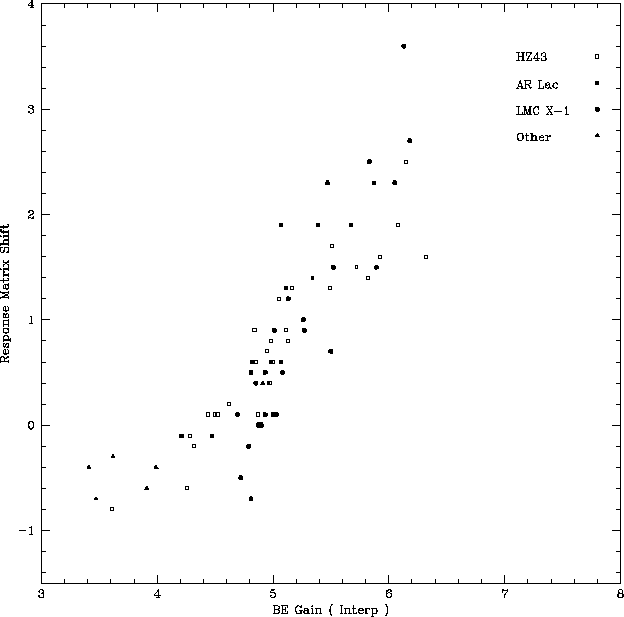As described in Section 2, the displacement of the PHA
distribution of an observation from prelaunch conditions can be
compensated by shifting the (ground-based) spectral response matrix
accordingly. Calibration sources have been analyzed to quantify the
relationship between the response matrix shift and the bright earth
gain state. The calibration sources are listed in
Table 3. The PHA distribution of each calibration
observation was fitted (in XSPEC) with a spectral model derived from
PSPC observations, initially using the ground-based (unshifted)
response matrix. The normalization was the only free parameter, and a
minimum ![]() derived. This procedure was repeated using response
matrices shifted in channel space (generated using the FTOOL
``gcorrmf''). Multiple response matrices were used with incremental
shifts of one-tenth of a channel. These matrices covered the whole
range of possible shifts between -1 and +4. This best fit incremental
shift was recorded. The corresponding gain state was determined from
the bright earth data for this detection position and observation
time. From 72 calibration observations, a direct correlation has been
shown to exist between the channel shift of the response matrix and
bright earth mean PHA channel (Figure
2 and 3).
derived. This procedure was repeated using response
matrices shifted in channel space (generated using the FTOOL
``gcorrmf''). Multiple response matrices were used with incremental
shifts of one-tenth of a channel. These matrices covered the whole
range of possible shifts between -1 and +4. This best fit incremental
shift was recorded. The corresponding gain state was determined from
the bright earth data for this detection position and observation
time. From 72 calibration observations, a direct correlation has been
shown to exist between the channel shift of the response matrix and
bright earth mean PHA channel (Figure
2 and 3).

Figure 2: The weighted bright earth gain level is plotted
against the response matrix shift which produces the minimum reduced
![]() value. The PHA channels 2-10 were included in the spectral
fits.
value. The PHA channels 2-10 were included in the spectral
fits.

Figure 3: The weighted bright earth gain level is plotted
against the response matrix shift which produces the minimum reduced
![]() value. The PHA channels 4-10 were included in the spectral
fits.
value. The PHA channels 4-10 were included in the spectral
fits.